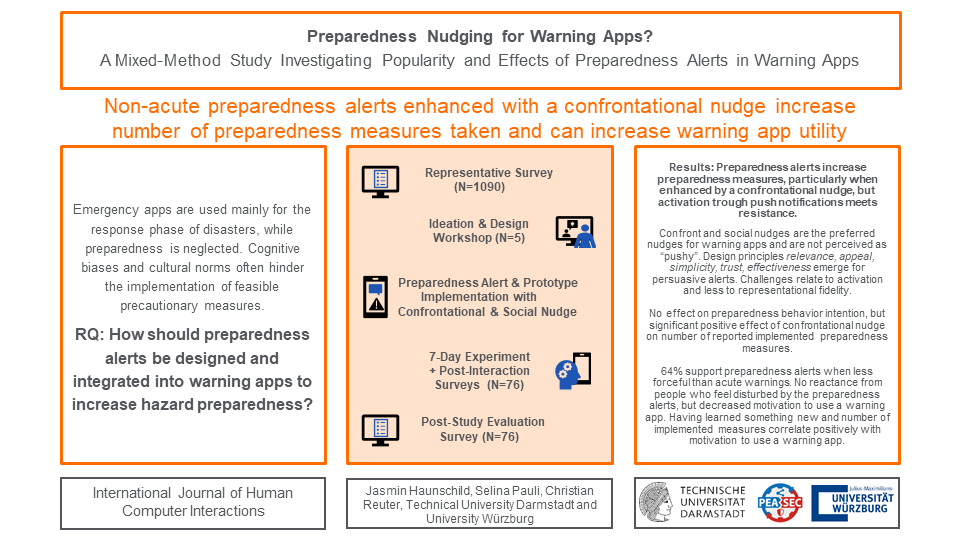Warning apps are used by many to receive warnings about imminent disasters. However, their potential for increasing awareness about general hazards and for increasing preparedness is currently underused. While warning apps usually include a menu item with preparedness advice, users have to proactively seek this information out. This is problematic, as cognitive biases and cultural norms lead people, especially in Germany, to postpone and neglect preparing for crises. With a mixed-method design that includes a representative survey of the German population, a design workshop and an app evaluation experiment, the new IJHCS study „Preparedness Nudging for Warning Apps? A Mixed-Method Study Investigating Popularity and Effects of Preparedness Alerts in Warning Apps” (available here for free until 8th March 2023), conducted by Jasmin Haunschild, Selina Pauli and Prof. Christian Reuter, investigates users’ preferences regarding non-acute preparedness alerts’ inclusion in crisis apps and the effectiveness of nudging in this context.
Question 1: Do users want push notifications with preparedness advice?
We thus designed a warning app feature that delivered preparedness advice as push notifications, ensuring that users would be confronted with preparedness information. We evaluated what participants thought about this intervention.
Results: We found that on the whole, as users expected warnings about acute disasters, they were opposed to the use of push notifications for non-immediate alerts. This suggests the need for more expectations management and that the feature should be optional. However, we also found that the more users perceived the preparedness information to be interesting, the more they liked the feature. Particularly, statistics were mentioned as having been interesting. The evaluation indicates that the preparedness alerts increased users’ knowledge and their motivation to use a warning app. This motivation, in contrast, decreases when the messages are perceived as a disruption. Whereas many oppose push notifications, most users favor finding persuasively designed preparedness advice in a separate menu or as an optional notification.
Question 2: Can we design the preparedness information in a way that motivates users to implement more crisis preparedness measures?
Motivational psychology research shows that the way information is presented influences behavior and the choices that people make. We therefore designed two app versions that included nudges: In one version, users were confronted with the negative consequences of not taking the recommended action (confrontational nudge). In the other version, it was suggested that taking precautions also increased the safety of others (social nudge). These nudges had emerged as the preferred ones in a previous representative study that we conducted.
Results: The experiment showed that the social influence nudge had no significant effect compared to the control group without a nudging condition. However, the confrontational nudge increased the number of recommended preparedness measures that were taken.
Summary: The study thus shows how framing preparedness information in a way that quantifies the potential gains and losses related to preparedness measures can make users adopt more measures. However, getting all users to engage with this information, without using push notifications, remains a challenge. As a starting point, preparedness alerts could be sent only to users who opt for the feature, or in a themed preparedness week that is communicated transparently, thus making users aware that push notification can include non-acute information, and that offers users the option of opting out. In this way, those users interested in doing more for their crisis preparedness could be supported without deterring other users.

